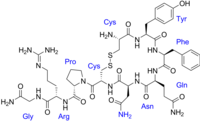
Expression of circadian clock genes in leukocytes of patients with Meniere's disease
Sign Up to like & getrecommendations! Published in 2022 at "Laryngoscope Investigative Otolaryngology"
DOI: 10.1002/lio2.757
Abstract: The underlying etiology of Meniere's disease (MD) is not completely clear, but the precipitated triggers may alter the circadian clock in patients with MD. This study aims to survey the expression of circadian clock genes… read more here.
Keywords: circadian clock; expression circadian; leukocytes patients; meniere disease ... See more keywords

Circadian rhythms of the mRNA abundances of clock genes and glucose transporters in the jejunum of weanling-growing pigs.
Sign Up to like & getrecommendations! Published in 2022 at "Veterinary medicine and science"
DOI: 10.1002/vms3.746
Abstract: BACKGROUND Whether abundance of glucose transporter mRNAs in the small intestine of pigs shows circadian rhythms and its regulation by clock genes was still unknown. OBJECTIVES We examined whether the abundance of glucose transporters and… read more here.
Keywords: clock genes; circadian rhythms; abundance; mrna ... See more keywords

Searching Novel Clock Genes Using RNAi-Based Screening.
Sign Up to like & getrecommendations! Published in 2021 at "Methods in molecular biology"
DOI: 10.1007/978-1-0716-0381-9_8
Abstract: RNA interference (RNAi) allows for the selective downregulation of gene expression by neutralizing targeted mRNA molecules and has frequently been used in high-throughput screening endeavors. Here, we describe a protocol for the highly parallel RNAi-mediated… read more here.
Keywords: searching novel; rnai; using rnai; novel clock ... See more keywords

Circadian Clock Regulation on Lipid Metabolism and Metabolic Diseases.
Sign Up to like & getrecommendations! Published in 2020 at "Advances in experimental medicine and biology"
DOI: 10.1007/978-981-15-6082-8_5
Abstract: The basic helix-loop-helix-PAS transcription factor (CLOCK, Circadian locomotor output cycles protein kaput) was discovered in 1994 as a circadian clock. Soon after its discovery, the circadian clock, Aryl hydrocarbon receptor nuclear translocator-like protein 1 (ARNTL,… read more here.
Keywords: clock regulation; metabolism; circadian clock; clock ... See more keywords

Melatonin, clock genes and mitochondria in sepsis
Sign Up to like & getrecommendations! Published in 2017 at "Cellular and Molecular Life Sciences"
DOI: 10.1007/s00018-017-2610-1
Abstract: After the characterization of the central pacemaker in the suprachiasmatic nucleus, the expression of clock genes was identified in several peripheral tissues including the immune system. The hierarchical control from the central clock to peripheral… read more here.
Keywords: sepsis; melatonin; innate immunity; clock ... See more keywords

The kinetics in mathematical models on segmentation clock genes in zebrafish
Sign Up to like & getrecommendations! Published in 2018 at "Journal of Mathematical Biology"
DOI: 10.1007/s00285-017-1138-1
Abstract: Somitogenesis is the process for the development of somites in vertebrate embryos. This process is timely regulated by synchronous oscillatory expression of the segmentation clock genes. Mathematical models expressed by delay equations or ODEs have… read more here.
Keywords: segmentation; segmentation clock; model; mathematical models ... See more keywords

The Influence of Short-term Fasting on Muscle Growth and Fiber Hypotrophy Regulated by the Rhythmic Expression of Clock Genes and Myogenic Factors in Nile Tilapia
Sign Up to like & getrecommendations! Published in 2018 at "Marine Biotechnology"
DOI: 10.1007/s10126-018-9846-0
Abstract: Circadian clock genes and myogenic factors are tightly integrated to influence muscle growth upon dietary deprivation in animals. In this study, we reported that upon short-term fasting of Nile tilapia juveniles for 7 and 15 days,… read more here.
Keywords: genes myogenic; muscle; expression; growth ... See more keywords

Therapeutic effects of curcumin on age-induced alterations in daily rhythms of clock genes and Sirt1 expression in the SCN of male Wistar rats
Sign Up to like & getrecommendations! Published in 2018 at "Biogerontology"
DOI: 10.1007/s10522-018-09794-y
Abstract: The aging brain is linked to accumulation of oxidative stress and increase in damage to biomolecules which in turn may cause or promote circadian dysfunction by disruption of biological clock, the suprachiasmatic nucleus (SCN). Age… read more here.
Keywords: age; scn; expression; daily rhythms ... See more keywords

Circadian clock genes’ overexpression in Drosophila alters diet impact on lifespan
Sign Up to like & getrecommendations! Published in 2018 at "Biogerontology"
DOI: 10.1007/s10522-018-9784-2
Abstract: Diet restriction is one of the most accurately confirmed interventions which extend lifespan. Genes coding circadian core clock elements are known to be the key controllers of cell metabolism especially in aging aspect. The molecular… read more here.
Keywords: core clock; overexpression; diet restriction; clock ... See more keywords

Quercetin, caffeic acid and resveratrol regulate circadian clock genes and aging-related genes in young and old human lung fibroblast cells
Sign Up to like & getrecommendations! Published in 2019 at "Molecular Biology Reports"
DOI: 10.1007/s11033-019-05194-8
Abstract: The circadian timing system of mammals is synchronized in concert with a central clock, but is also influenced by additional stimuli, including nutrients. However, little research has been done on polyphenols other than resveratrol and… read more here.
Keywords: caffeic acid; resveratrol; fibroblast cells; clock ... See more keywords

Circadian clock genes and circadian phenotypes in patients with myocardial infarction.
Sign Up to like & getrecommendations! Published in 2019 at "Advances in medical sciences"
DOI: 10.1016/j.advms.2018.12.003
Abstract: PURPOSE Human physiological activities and diseases are under the control of the circadian rhythm. There are strong epidemiological associations between disrupted circadian rhythms, sleep duration and diseases. Sleep disorders are associated with vascular outcomes, such… read more here.
Keywords: myocardial infarction; circadian clock; circadian phenotypes; clock ... See more keywords